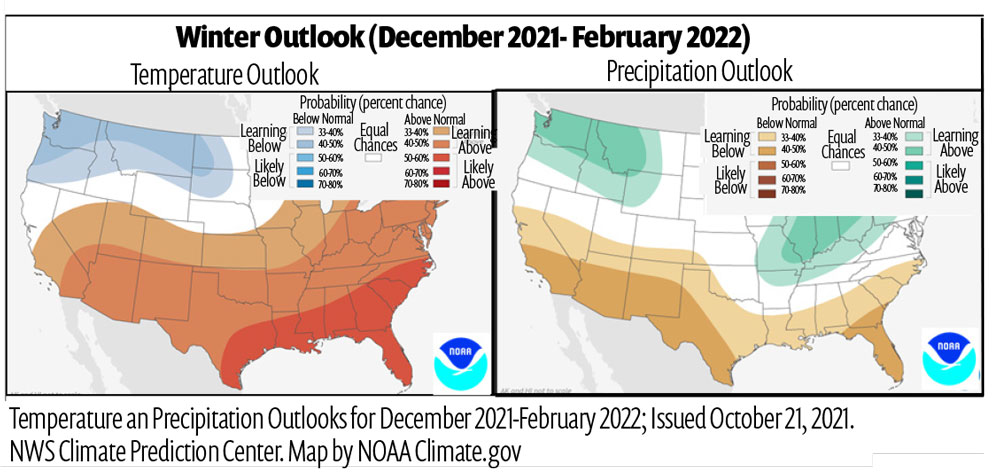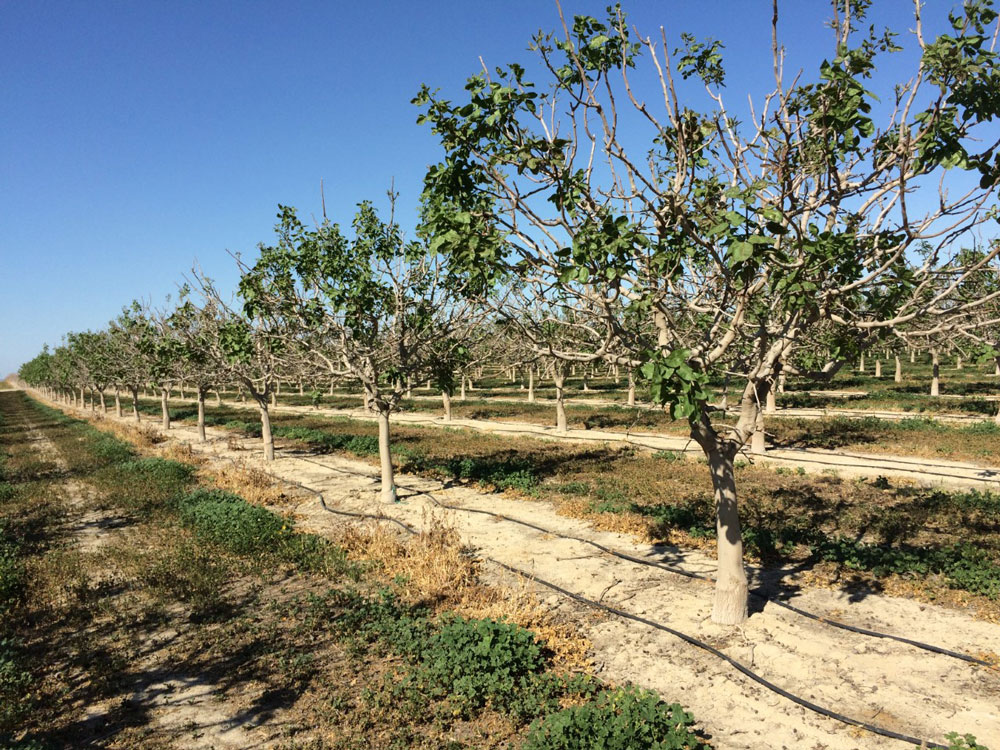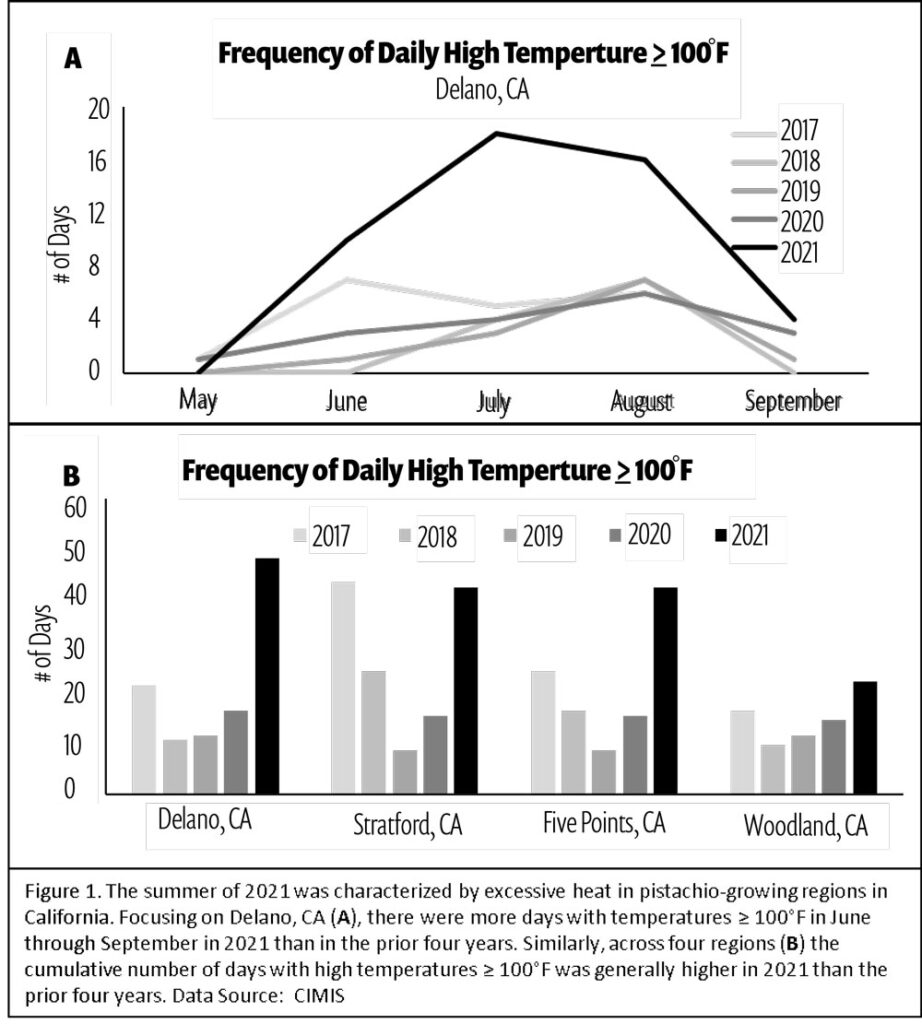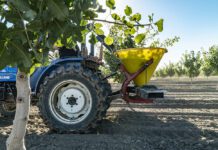
The pistachio industry has thrived in the southern San Joaquin Valley (SSJV) of California due to the unique climate that historically contributes adequately to the accumulation of heat units in the summer to promote crop development and chill units in the winter to break dormancy for production of the successive crop.
Climate Anomalies
Climate anomalies are not uncommon, with the recent 2021 summer characterized by excessive heat throughout California’s main pistachio-growing regions (Figure 1a, see page 27). The abnormally hot summer, characterized by over 40 days with high temperatures at or above 100 degrees F in the SSJV (Figure 1b, see page 27), may now be followed by an unusually warm winter as predicted by the National Oceanic and Atmospheric Administration’s (NOAA) Climate Prediction Center (Figure 2). Insufficient chill this winter may challenge pistachio production in 2022.
On Oct. 21, 2021, the NOAA reported that predicted winter conditions, consistent with La Nina, are likely to be warmer than usual in the SSJV. Additionally, precipitation in the SSJV is likely to be lower than average and drought conditions may continue to worsen. Based on the same model, the Sacramento Valley may expect normal winter temperatures, but is not exempt from the probability of below-average precipitation.
Consequences of Low Chill on Pistachio
Many temperate crops, including pistachio, require a cumulative amount of chilling to exit dormancy in the spring. The chilling requirement is a physiological mechanism that protects buds from the winter cold. Without a chilling requirement, budbreak could occur during intermittent winter warming events, thus exposing open buds, flowers or shoots to cold conditions that may limit survival of the structure. Chill hours are not calculated on a continuous basis, but rather in a cumulative fashion throughout the winter.
When the chilling requirement for pistachio is not fulfilled, vegetative and reproductive abnormalities may be observed in the spring. Bud break may be delayed or irregular (Figure 3, see page 27), often resulting in multiple phenological stages present on the same branch. Insufficient chill may result in protracted progression of bud break, whereas sufficient chill is correlated with a more condensed duration of bud break (Afshari et al. 2009). Lack of adequate chill has also been associated with abscission of floral buds as well as altered flower morphology and reduced fruit set. Pollination rates may be reduced due to asynchronous bloom of male and female trees as well as poor pollen production and death of the stigma (Crane and Takeda 1978). The resulting reduction in fruit set is associated with an increased proportion of blanks, unsplit nuts, late maturation, and a general reduction in yield (Crane and Takeda 1978). As a pollination management strategy, some growers have opted to plant multiple male genotypes in orchards to extend the duration of pollen availability.

Studies conducted by UC scientists determined that ‘Peters’ males have a higher chilling requirement than their ‘Kerman’ female counterpart. ‘Peters’ males require at least 900 hours below 45 degrees C to achieve 50% bloom. The ‘Kerman’ female requires 700 hours below 45 degrees C to achieve 44% bloom (Ferguson et al. 2002). The chilling requirements for new varieties, such as ‘Golden Hills’ and ‘Lost Hills,’ have yet to be assessed.
Chill Models
Various chill models used by physiologists are not laws of nature, but rather statistical models used to represent plant response to chill-related variables. In short, each model simply calculates the chill-related variable slightly differently.

The model achieving the “best fit” may vary from year to year simply because no two years have identical temperature fluctuation profiles from November through February. The simplest model, the Chilling Hour Model, is a summation of the hours below 45 degrees F. It is this model that was used to establish the 900- and 700-hour chilling requirement for ‘Peters’ and ‘Kerman,’ respectively.
A modified model accounts only for chilling hours accumulated between 32 degrees F and 45 degrees F; these are called ‘Modified Chill Hours.’ Two other models, the Utah Model and the Dynamic Model, attempt to characterize the influence of intermittent warmer temperatures on chill accumulation and are represented by ‘Chill Units’ and ‘Chill Portions,’ respectively. When comparing the Chilling Hour Model and the Dynamic Model, 900 chill hours converts to approximately 69 chill portions in California’s Central Valley (Pope et al. 2015).
Chill model calculation tools are available online at the UC ANR Fruit and Nut Research and Information Center (FNRIC) website (fruitsandnuts.ucanr.edu). To utilize these models, a grower can click on the model of interest and choose the CIMIS (California Irrigation Management Information Center) station nearest their orchard. Data from CIMIS stations are available for four locations in each of Tulare and Kern counties, two locations in each of Kings and Madera counties, and nine locations in Fresno County. One limitation of these calculators is the reliance on information from CIMIS stations and not from individual orchards and microclimates; however, the online calculators do allow for comparisons over successive years by providing access to historic, archived CIMIS data.
Chill is Not Everything
Adequate chill is not the sole determinant of orchard productivity. A recent study of historic yield records demonstrated that pistachio yields did not fall below average until chill portions dropped below 57 (Pope et al. 2015). Recalling that the 900 chill hours required for ‘Peters’ converts to approximately 69 chill portions in the Central Valley, one can conclude that it takes more than a reduction of chill portions below 69 to affect the yield at a state level.
Another study utilizing 30 years of production data from three ‘Kerman’ orchards identified four main factors responsible for over 65% of the variability in yield (Kallsen 2017). In this study, the main factors influencing yield included 1) yield in the prior year; 2) warm spring temperatures (>80 degrees F) prior to bloom; 3) cool temperatures (<45 degrees F) from mid-November through mid-February; and 4) warm temperatures (>65 degrees F) from mid-November through mid-February. If four variables accounted for 65% of the variability in yield in the Kallsen (2017) study, then the other 35% of yield may be influenced by many other orchard management practices throughout the year.
In summary, the chill calculators are tools that may be utilized to make comparisons of chill accumulation between years and assess the progress of chill accumulation during a given season. The model outputs are limited by the input data sourced from CIMIS stations at discreet locations that might not adequately reflect the environmental parameters of a given orchard. In addition to chill accumulation, growers should consider other mitigating factors, such as microclimates, propensity for inversions and historical yield data to assess the future orchard productivity potential.











